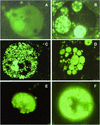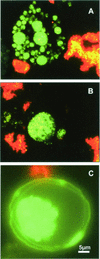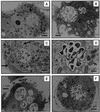Survival and growth of Francisella tularensis in Acanthamoeba castellanii
- PMID: 12514047
- PMCID: PMC152416
- DOI: 10.1128/AEM.69.1.600-606.2003
Survival and growth of Francisella tularensis in Acanthamoeba castellanii
Abstract
Francisella tularensis is a highly infectious, facultative intracellular bacterium which causes epidemics of tularemia in both humans and mammals at regular intervals. The natural reservoir of the bacterium is largely unknown, although it has been speculated that protozoa may harbor it. To test this hypothesis, Acanthamoeba castellanii was cocultured with a strain of F. tularensis engineered to produce green fluorescent protein (GFP) in a nutrient-rich medium. GFP fluorescence within A. castellanii was then monitored by flow cytometry and fluorescence microscopy. In addition, extracellular bacteria were distinguished from intracellular bacteria by targeting with monoclonal antibodies. Electron microscopy was used to determine the intracellular location of F. tularensis in A. castellanii, and viable counts were obtained for both extracellular and intracellular bacteria. The results showed that many F. tularensis cells were located intracellularly in A. castellanii cells. The bacteria multiplied within intracellular vacuoles and eventually killed many of the host cells. F. tularensis was found in intact trophozoites, excreted vesicles, and cysts. Furthermore, F. tularensis grew faster in cocultures with A. castellanii than it did when grown alone in the same medium. This increase in growth was accompanied by a decrease in the number of A. castellanii cells. The interaction between F. tularensis and amoebae demonstrated in this study indicates that ubiquitous protozoa might be an important environmental reservoir for F. tularensis.
Figures






References
-
- Berdal, B. P., R. Mehl, N. K. Meidell, A. Lorentzen-Styr, and O. Scheel. 1996. Field investigations of tularaemia in Norway. FEMS Immunol. Med. Microbiol. 13:191-195. - PubMed
Publication types
MeSH terms
Substances
LinkOut - more resources
Full Text Sources
Other Literature Sources

